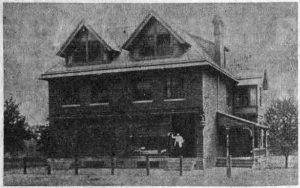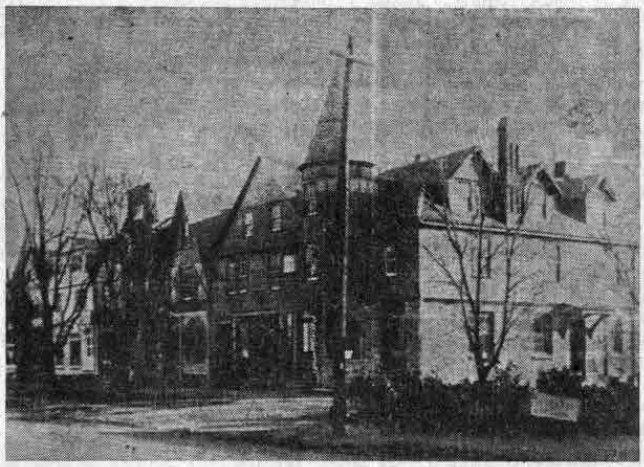 The two pictures used to illustrate today’s column show Wayne’s business block as it looked in the early nineties. Since that time, business has spread out in four directions from the intersection of Lancaster pike and North and South Wayne avenues, the real center of Wayne. With all this increase in the number of business houses and shops over the years the term “business block” is still used to designate only this one section, the block on the south side of Lancaster pike, bounded on the east by Louella avenue and on the west by South Wayne avenue.
The two pictures used to illustrate today’s column show Wayne’s business block as it looked in the early nineties. Since that time, business has spread out in four directions from the intersection of Lancaster pike and North and South Wayne avenues, the real center of Wayne. With all this increase in the number of business houses and shops over the years the term “business block” is still used to designate only this one section, the block on the south side of Lancaster pike, bounded on the east by Louella avenue and on the west by South Wayne avenue.
The fist picture shows the building which originally stood on the southeast corner of the Pike and South Wayne avenue, the present site of the Sun Ray Drug Store. It was a double-house building, with space downstairs for two stores and a room over each of these stores for living quarters. At first only the corner store was occupied.
When J.M. Fronefield, Jr., first came to Wayne in 1880 to establish a small country drug store, he located in the eastern end of the “Opera House”, now the Colonial Building. By 1893 he had moved into new quarters across the street, having purchased the building now shown in today’s picture. His family lived upstairs, where the present Joe Fronefield, of real estate fame, tells us he was born. Shortly after that his family moved to the large house on West Lancaster avenue now occupied by the Wayne Beauty Salon.
At first, the east side of the double house on the corner, which had been purchased by Mr. Fronefield, remained empty. Then the Lienhardt family moved there, where Mrs. Lienhardt established her well-known bakery on the first floor, reserving the second floor for living quarters. Old annals of Wayne from which your columnist quoted several years ago describe Mr. Fronefield as “Wayne’s first business man”. Several “Township Fathers” are listed, but only one “Town Mother”, as Mrs. Lienhardt was officially designated. Of her that particular historian has written, “Mrs. Lienhardt was a splendid business woman and an outstanding person of those days, and as long as she lived she held a warm place in the hearts of Wayne people. And what a Mecca that store was for children.”
In looking at this old picture with Joe Fronefield earlier in the week, your columnist learned many interesting facts about this early business corner of Wayne. The porch shown to the right was used by the Fronefields for family purposes as long as they lived there. After they moved west on the pike the porch was enclosed, making a small barber shop. At one time Philip DeMarse, who still operates in the Theatre Building, had his shop there. Back of the barber shop was Irving Leighton, a “Merchant Tailor” of the nineties who advertised in the “Wayne Directory and Blue Book” as making a specialty of “Custom and Ladies’ Work”. To the south of the Leighton’s place and in a separate building was Bob McCaig’s shoe repair shop. Back of this shop was a small stable, which was converted into Wayne’s first Chinese laundry.
The figure standing in the doorway in today’s picture is J.M. Fronefield, in his apothecary’s white coat. With a magnifying glass the reader can see the mortar and pestle of his trade on a sign at the right of the building. In front of the store are two objects of interest which have now outgrown their usefulness – an oil street lamp and a hitching post rail, which, according to one historian of the time, had “enough ties on it to accommodate any number of buggies”. Those were the days when “the narrow roadway that was the pike was all that the horse and wagon traffic demanded” and “buyers in Wayne shopped in comfort beneath ample shade trees”.
Only the eastern end of the original corner building now remains. Under new management, the bakery in operation there still retains the old Lienhardt name. “The former porch has been converted into the “Country Cousin” shop and the jewelry store operated by George K. Weaver. The Lienhardts’ side yard was sold to the Harrisons for the site of their present store.
In 1910, Mr. Fronefield sold his business to Harry LaDow, who in turn sold it to Claude LaDow. The store later passed from Mr. LaDow’s ownership to that of Media Drug Store. Then the Media chain sold out to Sun Ray Drug Company, which now operates one of its many stores there.
Joe Fronefield recalls to your columnist’s memory the interesting fact that the present store was built around the old one while Mr. LaDow still conducted his business in the latter place. After the outer shell of the new building was completed, the old store was demolished.
The stores on the rest of the block which are shown in our second picture as they originally appeared, will be described in a later column in this series. Suffice it today to call attention to the small curb sign at the right of the picture, which with the help of a magnifying glass may be deciphered as reading “Christmas Trees for Sale”. This picture must have been taken some 60 years or more ago at this season of the year.
(To be continued)

